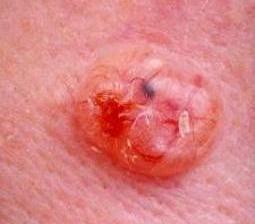Basal Cell Carcinoma (BCC) is the most common form of skin cancer. It is derived from the basal or deepest layers of the epidermis (outer layer of skin).
BCC usually appears as a red, fleshy nodule or patch on the skin. More aggressive forms of BCC may appear scar like (Morphoeic subtype), or as an ill defined pale to pink patch (infiltrative or micronodular subtypes) or even as a scaley crusting area (keratinising or basosquamous subtype). All of the aggressive subtypes can be more difficult to detect early, and for this reason will often be large and have caused extensive destruction of normal tissue prior to diagnosis. Expert skin checks can often detect these tumours at a stage before they are large and destructive, enabling more simple and cosmetically pleasing results from surgery to remove them.
Early Detection
BCCs commonly occur on the face of people who have grown up in warm tropical environments, and can occur in people who have never sun-baked. Even one episode of sun burn can result in BCCs arising in the area that was burn, and this includes parts of the body that are normally covered. There can be a delay of many years from sunburn to the appearance of the skin cancer. Signs to watch out for is the appearance of any red spot that persists for more than a few weeks, a spot that easily bleeds with wiping or towelling, or any spot that keeps scabbing or crusting and not completely going away, or keeps coming back after healing.



 Prevention Tips
Prevention Tips Early Detection
Early Detection Understanding Skin Cancer
Understanding Skin Cancer Success Stories
Success Stories Lifestyle and Skin Health
Lifestyle and Skin Health Advances in Treatment
Advances in Treatment Community & Events
Community & Events For Families
For Families What's Happening at Melanoma Scan?
What's Happening at Melanoma Scan?